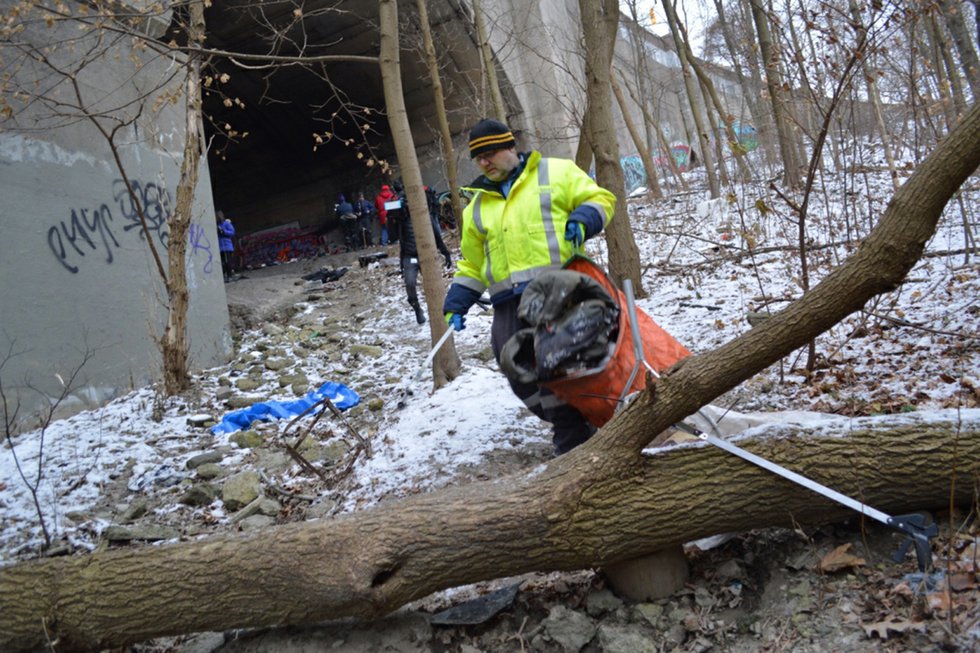
The City of Toronto continued its efforts to raze homeless encampments last week, even as it moves forward with a housing action plan.
The removal of belongings from the Rosedale ravine outraged housing advocates. They point out that the city’s shelters are already unsafe due to overcrowding, which is one reason why people create makeshift shelters in the first place.
But the erasure of encampments also raises questions about belonging and space, and the arbitrary patchwork of trespassing and loitering policies that people experiencing homelessness have to navigate in their daily lives to survive on the streets.
Last month, for example, an Ottawa Tim Hortons threatened to call the police on anyone who stayed in its store for more than 30 minutes. The store justified the move by saying that the store was trying to address instances of “extreme loitering.” The store eventually backed down following a social media storm.

Peter Biesterfeld
But for housing advocates, resisting discriminatory restrictions on the use of public and semi-public spaces does not go nearly far enough.
“Sometimes we miss the point about what the problem is and what we should be doing about it,” says Stephen Gaetz, president of the York University-based Canadian Observatory on Homelessness, one of the largest research institutes on the issue in the country. “We make all this investment in warehousing people, yet we know from research that it creates pathways to worsening life conditions.”

Peter Biesterfeld
Those who enter the shelter system are on average more likely to experience a decline in physical and mental health, criminalization, exposure to trauma and increased substance use.
It’s also expensive, costing an estimated $59,000 a year in various supports for every person experiencing homelessness. Gaetz says we could be providing permanent housing, including health and social supports, for less than half that.
We know from a growing number of examples that homelessness can be largely eradicated if we expand our response beyond emergency measures to include housing and prevention.
Finland offers an example in the EU where homelessness is falling because it offers people homes when they need them, unconditionally. Closer to home, Medicine Hat virtually eliminated homelessness by housing 1,072 people between 2009 and 2016. Edmonton has reduced overall homelessness by 43 per cent over the last decade.
In Toronto, on the other hand, there are 5,000 people occupying shelters on any given night. But social services charity Fred Victor pegs the number of people sleeping outdoors, in shelters or emergency centres, and in health and correctional facilities at closer to 10,000.
To put that number into perspective, there were 11,000 homeless people in New Orleans post-Hurricane Katrina.
Since then, New Orleans has reduced its homeless population by 90 per cent following exactly the template recommended by homeless advocates in Toronto – outreach, rent assistance and a housing policy that provides people with immediate access to permanent housing without any preconditions.
“The first thing people need is a good home,” says Kira Heineck, executive lead at the Toronto Alliance to End Homelessness, which is part of a national coalition to end homelessness.
The group advocates for the need for a two-pronged approach that accounts for the different reasons why people experience homelessness.

Peter Biesterfeld
One strategy would address those who need access to more affordable housing, which represents the majority of people experiencing homelessness. That includes provisions for more rent supplements in the short-term and more affordable housing in the long-term.
The second tries to address the needs of those experiencing chronic homelessness with more supportive and transitional housing.
“When we have a situation so highly visible at its extremes in places like encampments, we forget that almost 70 per cent of people in the shelter system are only there for economic reasons,” Heineck explains, noting that about two-thirds of those who enter the shelter system do so for only a matter of weeks.
“If we had resources in place to assist temporary shelter users, they wouldn’t have to enter into shelters at all, and then there would be a lot more space for people who need to use shelters for other reasons and for longer,” she says.
Gaetz agrees that preventing people from becoming homeless in the first place is as important as housing those experiencing homelessness. He pointed to Wales, where a duty-to-assist law requires local authorities to offer immediate help to anyone at risk of becoming homeless. “We need to retool the whole system to stop the inflow,” he says.
This is especially true of youth who experience homelessness. According to Gaetz, 50 per cent of people without shelter experience their first episode of homelessness before they age of 25.
“We wait until things get worse,” he says, “but if we did a better job with youth homelessness, we would do a better job overall.”
The HousingTO 2020-2030 Action Plan passed by Council in December promises 40,000 new affordable and supportive housing options. It also features a new income-based – rather than market-based – definition of affordable housing and enhanced measures to prevent evictions.
But commitments to build more affordable housing do not address immediate needs.
“It’ll take a minimum of three years for new housing to come online,” Heineck says. Rental supplements are capped at $600 to $800 but Heinick says they need to be about $1,000 to be effective in the current Toronto rental market.
She also points to conflicting provincial and municipal policies that can claw back access to rental supplements.
Gaetz is encouraged by recent investments in housing at the federal level but says provinces need to do more.
“Unfortunately, a lot of programs are still downloaded by provinces onto municipalities, and there is no strategic investment in prevention,” says Gaetz.
For housing advocates, the imperative to invest in prevention and housing is self-evident.
“We have to deliver,” Gaetz said. “Otherwise, we’ll still be talking about this 10 years from now.”

Peter Biesterfeld
@nowtoronto












